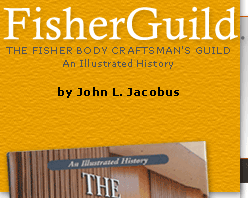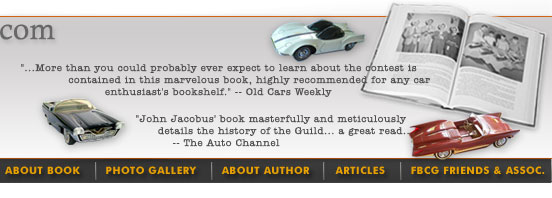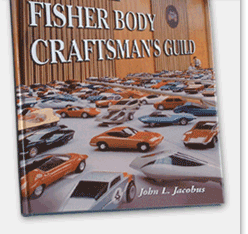|
Background
This book describes the history, memorabilia and
people of the Fisher Body Craftsman's Guild (1930-1968)
which consisted, initially, of contestants constructing
miniature model Napoleonic Coaches (1/18 scale)
from 1930 to 1948, and then 1/12 scale, futuristic
model "dream cars" from 1937 to 1968.
The top scoring models won university scholarship
trust funds for their creators, namely - teenage
boys and college age young men. Initially introduced
in the U.S., in 1932 the Canadians joined the
coach competition through GM Canada Ltd.
It was begun by the Fisher family as a philanthropic
project during the Great Depression, but evolved
into a successful talent search and recruiting
tool for General Motors Corporation. In the mid
to late 50's and internal study by Fisher Body
Division of the Craftsman's Guild's accomplishments
concluded that, other than the 206 Guild graduates
working at Fisher Body Central engineering, the
youth scholarship program was an important source
of design talent for GM Styling with 35% of GM
Stylists being Guild graduates in 1957. A July
22, 1960 head-count showed at least 47 Guildsmen
being employed by GM Styling with an average age
of 30 years. By 1985, 25 former Guildsman would
still be working at GM Design Staff, and today,
only a few remain at the GM Design Center.
It started as a foundation and became an educational
"movement" and successful design education
program for youth as well as a highly successful
public relations and advertising program which
generated considerable public "good will"
and huge corporate exposure. Although the relationship
between youth and future GM customers was recognized,
the overall purpose of the Guild program was to
generate public "good will" and because
the youth contestant's styling ideas were relatively
amateurish in nature, the contest did not stock
GM's inventory of new styling ideas. So successful
and institutionalized were the tenets, values
and virtues of the program that it continued for
34 years with the exception of World War II.
Beginning in 1965, the idea of the U.S. Craftsman's
Guild program was exported. GM Overseas Operations
Division got involved and Craftsman's Guild competitions
were born at Vauxhall (UK), GM Suisse (Switzerland),
Adam-Opel (West Germany) and at GM Holden (Australia).
Although these were mostly short lived experiments,
the Opel Modellbauer Gilde in West Germany, a
co-educational program, was conducted from 1965-1979.
A few girls finished among the top 40 model-makers
in the Vauxhall Motors Ltd. and Adam Opel contests.
On the average some 1,697 models were entered
annually in the Opel Moldellbauer Gilde competition
compared to an average of about 3,133 model entries
in the U.S. Craftsman's Guild competition.
The educational "movement" that the
Fisher Brothers had envisioned had become an international
education program and talent search forum. It
helped young people find their way in the world
- perhaps an advocation became a vocation or industry
design career. Maybe their vocational callings
switched from auto design to product design to
architectural design or from mechanical engineering
to engineering architecture, but the Guild got
them thinking about their futures and where they
fit in. Some became career automobile designers
working at GM, Ford, Chrysler, AMC, Nissan, Subaru
and Volvo reaching, in a few cases, the Director
of Design level. Others became top product designers
in interior and exterior architectural design,
home and office furniture and major appliances.
Some guildsmen were so talented as artists, engineers,
craftsmen, and/or designers, that without benefit
of formal education, they became independent and
successfully self-employed.
In 1968 all of this came to an end in the U.S.
when the corporate Executives at West Grand Boulevard
concluded that benefits of the Guild did not exceed
the costs. Because the number of new GM customers,
or the number of cars sold or the amount of "good
will" couldn't be measured or quantified,
the benefits side of the equation could never
be determined. Perhaps because it was co-educational
and formulated for the first phase of women's
liberation, the Opel Modellbauer Gilde continued
to flourish until 1979. This is consistent with
education institutions which over the years shifted
to co-education in order to survive.
As a tribute to the legacy of the Fisher Body
Craftsman's Guild, Automobile Quarterly
magazine sponsored three Car Styling Contests
(rendering/drawing contests), at various times
in the late 80's and early 90's, for aspiring
student and adult auto designers with the results
being judged by leading industry design executives.
In inaugurating their design competition, in which
there were hundred of entries, Automobile Quarterly
magazine stated the following:
"From 1930 to 1968, the Fisher Body Craftsman's
Guild sought to harness and nurture the visions
of American youth. Among its goals, of course,
was corporate visibility, but the Guild also produced
generations of designers, many of whom by dint
of persistent creativity, rose to the top ranks
of industrial design and today shape products
for that more perfect world. We honor their energy
and enthusiasm with a design contest that encourages
the visionaries of today to share their dreams
of tomorrow." (Automobile Quarterly,
1987, Vol. 25, No.2)
|



